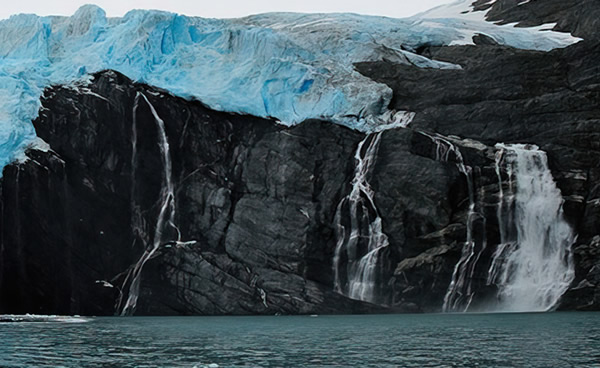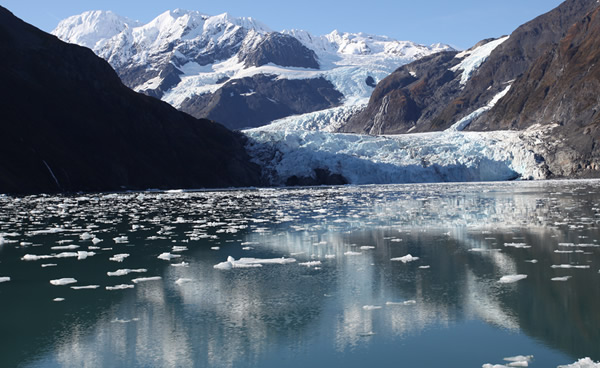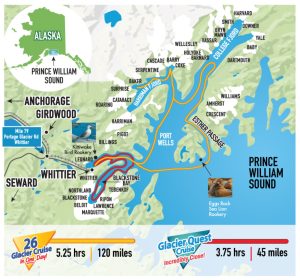Prince William Sound Glacier Cruise
Prince William Sound is known for its high concentration of glaciers and deeply carved fjords. There are over 100 named glaciers in Prince William Sound. Our cruises depart from Whittier and explore the western side of Prince William Sound. We travel past a variety of glaciers including alpine, piedmont and tidewater glaciers. To help you understand the difference between the glaciers, we have a glossary of glacier terms for your reference.

How are glaciers formed?
Glaciers form when more snow accumulates than is lost each year. All glaciers have an accumulation zone, areas where snow builds up, and an ablation zone, where snow and ice are lost. Glaciers are Rivers of moving ice-glaciers that slide and grind their way down mountains sculpting the fjords and valleys by the forces of gravity.

To help illustrate the terms you will hear during the cruise, please reference the numbers on this photo of Harvard Glacier in College Fjord as a visual for the coinciding listed definitions. We hope this helps you gain a better understanding of how glaciers are formed as snow and time combine to create glaciers.
1. Accumulation Zone Snow accumulates in the upper altitudes.
2. Snow Becomes Ice Snow gradually becomes ice under its own weight. New snowfall compresses the snow from previous seasons.
3. Tributary Glaciers Smaller glaciers that connect to larger glaciers.
4. Medial Moraine A ridge of moraine that runs down the center of a valley floor. It forms when two glaciers meet and the debris on the edges of the adjacent valley sides join and are carried on top of the enlarged glacier.
5. Lateral Moraine As the glaciers scrape the side of the mountain, the rock and dirt fall on top of the glacier forming a black stripe along the side of the glacier. Rockfall is a result of frost weathering of the rock wall and of over-steepening of the cliff by glacial erosion, leading to rock slope failure. The rock debris is carried along the edges of the glacier as it moves towards the snout or toe of the glacier.
6. Terminus Glaciers reach their maximum length when ice loss can no longer be replaced by snow accumulation in the upper regions. Glaciers retreat when ice loss is greater than snow accumulation and advance when snowfall is greater than ice loss.
Choose your cruise and count the glaciers
26 Glacier Cruise - Glaciers
Identify these Alpine, Valley, and Tidewater glaciers during the cruise.
- Passage Canal – Whittier Glacier, Billings Glacier
- Port Wells – Pigot Glacier, Cascade Glacier
- College Fjord – Barnard Glacier, Holyoke Glacier, Wellesley Glacier, Vassar Glacier, Bryn Mawr Glacier, Smith Glacier (Alaska), Harvard Glacier, Downer Glacier, Yale Glacier, Baby Glacier, Dartmouth Glacier, Williams Glacier, Amherst Glacier, Crescent Glacier
- Blackstone Bay – Tebenkof Glacier, Ripon Glacier, Lawrence Glacier, Marquette Glacier, Beloit Glacier, Blackstone Glacier, Northland Glacier, Concordia Glacier
Glacier Quest Cruise - Glaciers
Look for these Alpine, Valley, and Tidewater glaciers on the cruise.
- Passage Canal – Whittier Glacier, Billings Glacier
- Blackstone Bay – Tebenkof Glacier, Ripon Glacier, Lawrence Glacier, Marquette Glacier, Beloit Glacier, Blackstone Glacier, Northland Glacier, Concordia Glacier
Glossary of glacier terms
Glaciers are rivers of moving ice. Glaciers slide and grind their way down mountains sculpting the fjords and valleys by the forces of gravity.
Alpine or Hanging Glaciers are the smaller glaciers that are literally hanging on the side of a mountain.
Piedmont Glaciers from the French word “pied” meaning foot and “mont” meaning mountain, are glaciers that rest at the base of a mountain.
Tidewater Glaciers terminate at the ocean’s edge. As the glacier moves into the ocean, pressured by its own weight from behind, it is weakened by the warming action of the water, and giant slabs of ice break away and calve into the sea.
Calving A word meaning to break off or “calve”, is often accompanied by sharp crackling sounds or a thunder-like rumbling. Calving can be an awesome sight.
Icebergs are dense formations of ice that have calved off a glacier. An iceberg’s density is such that only about ten (10) percent, the “tip” of the iceberg, is visible above water. That means that 90 percent is underwater. This is what makes icebergs dangerous.
Moraines are created as the glacier pushes its way down the mountains, scraping along the bedrock, pushing rock and dirt into formations.
Terminal Moraine is the rock and dirt that is scraped up from the bedrock and pushed in front of a tidewater glacier as the glacier moves forward as it advances and left behind when the glacier retreats.
Why is the ice blue? Glacier ice is made of solid crystals. It is very dense. All colors of the light spectrum are absorbed into the thick ice except for blue. Blue, having the shortest wavelength and most energy in the color spectrum is refracted. Overcast days produce more blue color; when the sun is shining there is too much reflection and the ice appears washed out or white.
Are there such things as ice worms? Ice worms – cousins of the earthworm – live on top of glaciers and feed on pollen and red algae that grow on the glaciers. Ice worms burrow into the snow during the day to protect themselves from the heat of the sun and come out at night to feed. Ice worms cannot get into temperatures more than 40 F and less than 22 F or they will die. They are found only on glaciers near the ocean where the climate is warm enough for meltwater to be in the glacier at all times.

Why are Glaciers Blue?
Years of compression gradually forms very dense ice by forcing out the tiny air pockets between ice crystals. This dense ice absorbs the long wavelengths of light. However, short wavelengths of light are transmitted and scattered reflecting the color blue. Glacier ice appears white when there are many tiny air bubbles trapped inside.















